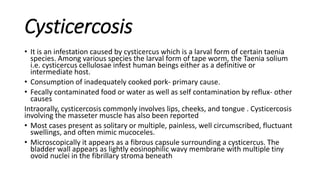Cysticercosis and Oral Myiasis
•Download as PPTX, PDF•
2 likes•3,036 views
Cysticercosis is an infestation caused by the larval form of the Taenia solium tapeworm, known as cysticercus cellulosae. Humans can act as either the definitive or intermediate host for this parasite. Consumption of undercooked pork is the primary cause, while other causes include ingestion of food or water contaminated with feces or self-contamination. Intraorally, cysticercosis commonly presents as painless, fluid-filled swellings involving the lips, cheeks, tongue, or masseter muscle that mimic mucoceles. Microscopically, the cysts appear as fibrous capsules surrounding the larval cysticerci. When cyst
Report
Share
Report
Share

Recommended
More Related Content
What's hot (20)
Cysticercosis -types symptoms| management |prevention (medical notes)

Cysticercosis -types symptoms| management |prevention (medical notes)
Similar to Cysticercosis and Oral Myiasis
Similar to Cysticercosis and Oral Myiasis (20)
Ulcerative & inflammatory diseases of oral cavity i

Ulcerative & inflammatory diseases of oral cavity i
Ulcerative & inflammatory diseases of oral cavity i n

Ulcerative & inflammatory diseases of oral cavity i n
PULP AND PERIAPICAL DISEASES-2 / oral surgery courses 

PULP AND PERIAPICAL DISEASES-2 / oral surgery courses
Hamster - Bacterial, Viral, Mycotic, Parasitic and Non infectious diseases

Hamster - Bacterial, Viral, Mycotic, Parasitic and Non infectious diseases
Recently uploaded
Recently uploaded (20)
call girls in munirka DELHI 🔝 >༒9540349809 🔝 genuine Escort Service 🔝✔️✔️

call girls in munirka DELHI 🔝 >༒9540349809 🔝 genuine Escort Service 🔝✔️✔️
call girls in green park DELHI 🔝 >༒9540349809 🔝 genuine Escort Service 🔝✔️✔️

call girls in green park DELHI 🔝 >༒9540349809 🔝 genuine Escort Service 🔝✔️✔️
epilepsy and status epilepticus for undergraduate.pptx

epilepsy and status epilepticus for undergraduate.pptx
Report Back from SGO: What’s New in Uterine Cancer?.pptx

Report Back from SGO: What’s New in Uterine Cancer?.pptx
Measurement of Radiation and Dosimetric Procedure.pptx

Measurement of Radiation and Dosimetric Procedure.pptx
Introduction to Sports Injuries by- Dr. Anjali Rai

Introduction to Sports Injuries by- Dr. Anjali Rai
Basic principles involved in the traditional systems of medicine PDF.pdf

Basic principles involved in the traditional systems of medicine PDF.pdf
call girls in Connaught Place DELHI 🔝 >༒9540349809 🔝 genuine Escort Service ...

call girls in Connaught Place DELHI 🔝 >༒9540349809 🔝 genuine Escort Service ...
COVID-19 (NOVEL CORONA VIRUS DISEASE PANDEMIC ).pptx

COVID-19 (NOVEL CORONA VIRUS DISEASE PANDEMIC ).pptx
VarSeq 2.6.0: Advancing Pharmacogenomics and Genomic Analysis

VarSeq 2.6.0: Advancing Pharmacogenomics and Genomic Analysis
See the 2,456 pharmacies on the National E-Pharmacy Platform

See the 2,456 pharmacies on the National E-Pharmacy Platform
Cysticercosis and Oral Myiasis
- 1. Cysticercosis • It is an infestation caused by cysticercus which is a larval form of certain taenia species. Among various species the larval form of tape worm, the Taenia solium i.e. cysticercus cellulosae infest human beings either as a definitive or intermediate host. • Consumption of inadequately cooked pork- primary cause. • Fecally contaminated food or water as well as self contamination by reflux- other causes Intraorally, cysticercosis commonly involves lips, cheeks, and tongue . Cysticercosis involving the masseter muscle has also been reported • Most cases present as solitary or multiple, painless, well circumscribed, fluctuant swellings, and often mimic mucoceles. • Microscopically it appears as a fibrous capsule surrounding a cysticercus. The bladder wall appears as lightly eosinophilic wavy membrane with multiple tiny ovoid nuclei in the fibrillary stroma beneath
- 2. • When a cyst dies spontaneously or following chemotherapy, there is usually more inflammation. Local eosinophilia, granulation tissue, and a granulomatous reaction follow.
- 3. Oral myiasis • Oral myiasis is defined as a condition in which the soft tissues of different parts of the oral cavity are invaded by the parasitic larvae of flies. These larvae commonly known as maggots are of Diptera. • Myiasis is associated with poor oral hygiene. • Usually the female fly infests ova in open wounds, dead tissue or normal body cavities. These eggs hatch and the larvae get their nourishment from the soft tissue. • It is relatively a rare condition but cases have been reported in gingiva, palate and extracted wounds. • The usual presenting symptoms are painful growth with ulceration and itching due to crawling movement of the larvae . • The treatment is aimed at the removal of the larvae from the affected area and flushing the area with normal saline or antiseptics.
